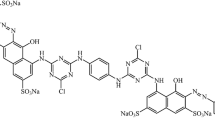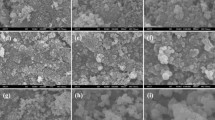Abstract
A number of semiconducting and bioactive nanocomposite systems based on TiO2 are designed for environmental protection. The presented structures based on titanium dioxide, formed in binary and ternary systems in the presence of gold, silver, cerium and iron with a different degree of crystallinity, were obtained by sol–gel method using titanium tetraisopropoxide (TTIP) as a precursor species. X-ray diffraction data confirmed a homogeneous composition of powders formed in binary systems (anatase modified with clusters of Au, Ag, and CeO2) and a heterogeneous composition of ternary systems with CSR in the range of 9–20 nm. As such, the XRD of the powders indicated the formation of heterogeneous structures: anatase—cerium dioxide—silver and anatase/brookite—hematite—gold or brookite—gold. Noble metals (Au, Ag) can be used to fill surface traps by donating electrons into 3d states of coordinated Ti ions. It was shown that the ternary composite TiO2-CeO2-Ag (2 wt.%) has improved photocatalytic properties due to the inclusion of CeO2 in the crystal lattice of anatase, which is confirmed by an increase in the degree of tetragonality of the lattice from 2.50 to 2.53, and prevention of oxidation of silver clusters on the surface of anatase under the influence of UV irradiation (98.4%). The photocatalytic efficiency was assessed through the removal and degradation of malachite green. More than 95% of dye solution was decolorized after 5 min of contact with all composites compared to pure TiO2 phase. Thus, the obtained structures are promising materials for creating photoactive catalysts to neutralize malachite green solutions.







Similar content being viewed by others
Data availability
Data are available to the authors upon request.
References
Arun J, Nachiappan S, Rangarajan G, Prasath Alagappan R, Gopinath KP, Lichtfouse E (2023) Synthesis and application of titanium dioxide photocatalysis for energy, decontamination and viral disinfection: a review. Environ Chem Lett 21:339–362. https://doi.org/10.1007/s10311-022-01503-z
Bouziani A, Park J, Ozturk A (2019) Synthesis of α-Fe2O3/TiO2 heterogeneous composites by the sol-gel process and their photocatalytic activity. J Photochem Photobiol A Chem. https://doi.org/10.1016/j.jphotochem.2020.112718
Buraso W, Lachom V, Siriya P, Laokul P (2018) Synthesis of TiO2 nanoparticles via a simple precipitation method and photocatalytic performance. Mater Res Express 5:115003. https://doi.org/10.1088/2053-1591/aadbf0
Castro AL, Nunes MR, Carvalho AP, Costa FM, Florêncio MH (2008) Synthesis of anatase TiO2 nanoparticles with high temperature stability and photocatalytic activity. Solid State Sci 10:602e606. https://doi.org/10.1109/JPHOT.2013.2262674
Clark Jim (2022) “Atomic and Ionic Radius”. Chemistry Libre Texts. 3 October 2013. https://chem.libretexts.org/Bookshelves/Physical_and_Theoretical_Chemistry_Textbook_Maps/Supplemental_Modules_(Physical_and_Theoretical_Chemistry)/Physical_Properties_of_Matter/Atomic_and_Molecular_Properties/Atomic_and_Ionic_Radius
Di Paola A, Bellardita M, Palmisano L (2013) Brookite, the least known TiO2 photocatalyst. Catalysts 3:36–73. https://doi.org/10.3390/catal3010036
Feng L, Wang H, Han X (2015) Preparation and catalytic performance of the CeO2/TiO2 composites. Mater Res Innov 19(sup8):S8-111-S8-113. https://doi.org/10.1179/1432891715Z.0000000001633
Gesesse GD, Li C, Paineau E, Habibi Y et al (2019) Enhanced photogenerated charge carriers and photocatalytic activity of biotemplated mesoporous TiO2 films with a chiral nematic structure. Chem Mater 31(13):4851–4863. https://doi.org/10.1021/acs.chemmater.9b01465
Gharavi-nakhjavani MS, Niazi A, Hosseini H et al (2023) Malachite green and leucomalachite green in fish: a global systematic review and meta-analysis. Environ Sci Pollu Res 30:48911–48927. https://doi.org/10.1007/s11356-023-26372-z
Gomes J, Lopes A, Bednarczyk K et al (2018) Effect of noble metals (Ag, Pd, Pt) loading over the effciency of TiO2 during photocatalytic ozonation on the toxicity of parabens. ChemEngineering 2(1):4. https://doi.org/10.3390/chemengineering2010004
Gondal MA, Rashid SG, Dastageer MA et al (2013) Sol-Gel synthesis of Au/Cu-TiO2 nanocomposite and their morphological and optical properties. IEEE Photonics J 5(3):2201908–2201908. https://doi.org/10.1109/JPHOT.2013.2262674
Hampel B, Baia L, Hernadi K, Pap Z (2021) The influence of the ratio of Au and Pt nanoparticles in ternary composites with TiO2. Metals 11:628. https://doi.org/10.3390/met11040628
Hanaor DA, Sorrell CC (2011) Review of the anatase to rutile phase transformation. J Mater Sci 46:855–874. https://doi.org/10.1007/s10853-010-5113-0
Jimenéz-Calvo P, Muñoz-Batista Mario J, Isaacs M et al (2023) A compact photoreactor for automated H2 photoproduction: revisiting the (Pd, Pt, Au)/TiO2 (P25) Schottky junctions. Chem Eng J 459:141514. https://doi.org/10.1016/j.cej.2023.141514
Kumar P, Ahmad B, Chand F, Asokan K (2018) Magnetic and electronic structures of Co ion implanted CeO2 thin films. Appl Surf Sci 452:217–222. https://doi.org/10.1016/j.apsusc.2018.04.263
Kusiak-Nejman E, Sienkiewicz A, Wanag A, Rokicka-Konieczna P, Morawski AW (2021) The role of adsorption in the photocatalytic decomposition of dyes on APTES-Modified TiO2 Nanomaterials. Catalysts 11:172. https://doi.org/10.3390/catal11020172
Lavrynenko OM, Zahornyi MM, Pavlenko OYu, Bykov AI (2022) Structure and thermal behavior of CeO2 and TiO2 nanopowders doped with noble metals. Appl Nanosci. https://doi.org/10.1007/s13204-022-02706-0
Li J, Jiménez-Calvo P, Paineau E, Ghazzal MN (2020) Metal chalcogenides based heterojunctions and novel nanostructures for photocatalytic hydrogen evolution. Catalysts 10:89. https://doi.org/10.3390/catal10010089
Li Z, Li Z, Zuo C, Fang X (2022) Application of nanostructured TiO2 in UV photodetectors: a review. Adv Mater 34:2109023. https://doi.org/10.1002/adma.202109083
Mei Q, Zhang F, Wang N, Yang Y, Wu R, Wang W (2019) TiO2/Fe2O3 heterostructures with enhanced photocatalytic reduction of Cr(VI) under visible light irradiation. RSC Adv 9:22764. https://doi.org/10.1039/C9RA03531A
Mezni A, Ibrahim MM, Saber NB et al (2021) Ternay Au@TiO2/α-Fe2O3 nanocomposite with nanoring structure: synthesis, characterization and photocatalytic activity. J Inorg Organomet Polym Mater 31:4372–4379. https://doi.org/10.1007/s10904-021-02033-x
Montanhera MA, Venancio RHD, Pereira ÉA et al (2021) Synthesis of TiO2 tubes via dissolution of TiOSO4 rod using H2O2. Mat Res 24(2):e20200377. https://doi.org/10.1590/1980-5373-mr-2020-0377
Nagajyothi PC, Prabhakar Vattikuti SV, Devarayapalli KC et al (2020) Green synthesis: photocatalytic degradation of textile dyes using metal and metal oxide nanoparticles-latest trends and advancements. Crit Rev Env Sci Technol 50:2617–2723. https://doi.org/10.1080/10643389.2019.1705103
Pelaez M, Nolan NT, Pillai SC et al (2012) A review on the visible light active titanium dioxide photocatalysts for environmental applications. Appl Catal B 37:91–105. https://doi.org/10.1016/S0926-3373(01)00335-6
Pigeot-Rémy S, Gregori D, Hazime R, Hérissan A et al (2018) Size and shape effect on the photocatalytic efficiency of TiO2 brookite. J Mater Sci. https://doi.org/10.1007/s10853-018-2924-x
Quintero Y, Mosquera E, Diosa J, García A (2020) Ultrasonic-assisted sol-gel synthesis of TiO2 nanostructures: Influence of synthesis parameters on morphology, crystallinity, and photocatalytic performance. J Sol-Gel Sci Technol 94:477–485. https://doi.org/10.1007/s10971-020-05263-6
Ribao P, Rivero MJ, Ortiz I (2017) TiO2 structures doped with noble metals and/or graphene oxide to improve the photocatalytic degradation of dichloroacetic acid. Environ Sci Pollut Res Int. https://doi.org/10.1007/s11356-016-7714-x
Thiripuranthagan S, Rupa V (2019) Detoxification of carcinogenic dyes by noble metal (Ag, Au, Pt) impregnated titania photocatalysts, gold nanoparticles—reaching new heights. IntechOpen. https://doi.org/10.5772/intechopen.80467
Torrell M, Adochite RC, Cunha L, Barradas NP et al (2012) Surface plasmon resonance effect on the optical properties of TiO2 doped by noble metals nanoparticles. J Nano Res 18–19:177–185. https://doi.org/10.4028/www.scientific.net/JNanoR.18-19.177
Upadhyaya A, Rincon G (2019) Visible-light-active noble-metal photocatalysts for water disinfection: a review. J Water Resour Protect 11:1207–1232. https://doi.org/10.4236/jwarp.2019.1110070
Wang C, Ghazzal MN (2023) Nanostructured TiO2 for improving the solar-to-hydrogen conversion efficiency. Energy Adv. https://doi.org/10.1039/D3YA00089C
Wang J, Meng F, Xie W et al (2018) TiO2/CeO2 composite catalysts: synthesis, characterization and mechanism analysis. Appl Phys A 124:645. https://doi.org/10.1007/s00339-018-2027-1
Zahornyi M, Sokolsky G (2022) Nanosized titania composites for reinforcement of photocatalysis and photoelectrocatalysis. Cambridge Scholars Publishing, UK, p 275
Žerjav G, Žižek K, Zavašnik J, Pintar A (2022) Brookite vs. rutile vs. anatase: what’s behind their various photocatalytic activities. J Environ Chem Eng 10(3):107722. https://doi.org/10.1016/j.jece.2022.107722
Zheng ZK, Huang BB, Qin XY et al (2011) Facile in situ synthesis of visible-light plasmonic photocatalysts M@TiO2 (M = Au, Pt, Ag) and evaluation of their photocatalytic oxidation of benzene to phenol. J Mater Chem 21:9079–9087. https://doi.org/10.1039/C1JM10983A
Zheng L, Teng F, Ye X, Zheng H, Fang X (2020) Photo/electrochemical applications of metal sulfide/TiO2 heterostructures. Adv Energy Mater 10:1902355. https://doi.org/10.1002/aenm.201902355
Zuas O, Hamim N (2013) Synthesis, characterization and properties of CeO2-doped TiO2 composite nanocrystals. Mater Sci. https://doi.org/10.5755/j01.ms.19.4.2732
Acknowledgements
The authors express gratitude to the Head of the Laboratory of Electron Microscopy M.A. Skoryk (Laboratory of Electronic Microscopy LLC “Nano Technologies in Medicine” NanoMedTech) for the obtaining of the SEM images and EDS spectra, O. I. Bykov (I. Frantsevich Institute for Problems of Materials Science, NAS of Ukraine) for the obtaining and discussion of XRD results, and V.V. Strelchuk, O.F. Kolomys (V. Lashkaryov Institute of Semiconductor Physics, NAS of Ukraine) for the PL tested of samples). The Laboratoire de Physique des Solides is supported by the PAUSE program, a national emergency program for scientists and artists in exile, run by the Collège de France.
Author information
Authors and Affiliations
Corresponding author
Ethics declarations
Conflict of interest
The author(s) declare that they have no conflict of interest.
Ethical approval
Not applicable.
Humans and/or animals participants
Not applicable.
Consent to participate
Not applicable.
Consent for publication
Not applicable.
Additional information
Publisher's Note
Springer Nature remains neutral with regard to jurisdictional claims in published maps and institutional affiliations.
Rights and permissions
Springer Nature or its licensor (e.g. a society or other partner) holds exclusive rights to this article under a publishing agreement with the author(s) or other rightsholder(s); author self-archiving of the accepted manuscript version of this article is solely governed by the terms of such publishing agreement and applicable law.
About this article
Cite this article
Lavrynenko, O.M., Zahornyi, M.M., Paineau, E. et al. Synthesis of active binary and ternary TiO2-based nanocomposites for efficient dye photodegradation. Appl Nanosci 13, 7365–7377 (2023). https://doi.org/10.1007/s13204-023-02909-z
Received:
Accepted:
Published:
Issue Date:
DOI: https://doi.org/10.1007/s13204-023-02909-z




